Bringing a new canine companion into your home is an exciting prospect, but it also comes with practical considerations. For many prospective pet parents, the thought of constant fur shedding can be a major deterrent, leading them to seek out medium dog breeds that don’t shed or at least shed minimally. Beyond the aesthetics of a clean home, concerns about allergies often drive this search. While no dog is truly 100% “non-shedding” – all dogs lose some hair – many breeds are classified as “low-shedding” because their hair cycles differently or gets trapped within their coat, significantly reducing the amount of fur released into the environment.
However, it’s crucial to understand that low shedding often implies a higher demand for regular grooming. These breeds typically require more frequent brushing, professional stripping, or clipping to maintain healthy skin and coats and to prevent matting. For those ready to commit to a grooming routine, the benefits of a low-shedding companion are clear. This comprehensive guide will explore some of the best medium-sized dog breeds that are known for their minimal shedding, detailing their unique coat care requirements to help you make an informed decision for your home.
Understanding “Low-Shedding” and Essential Grooming Needs
The term “non-shedding” is a common misconception in the dog world. Every dog sheds, but the degree and visibility of shedding vary dramatically between breeds. Low-shedding dogs often have hair that grows continuously, much like human hair, or a dense double coat that traps loose hair rather than releasing it into your home. This distinction is vital because while you might find less fur on your furniture, the responsibility of removing that trapped or continuously growing hair falls directly on the owner.
Proper grooming is not just about aesthetics; it’s essential for your dog’s health and comfort. Neglecting the coat of a low-shedding breed can lead to painful matting, skin irritation, and even infections. Depending on the breed, grooming might involve daily brushing, weekly baths, and regular visits to a professional groomer for clipping or hand stripping. Different coat types—wiry, curly, corded, or silky—each present unique grooming challenges and benefits. Understanding these needs upfront is key to a happy, healthy relationship with your low-shedding companion.
Top 10 Medium Dog Breeds That Don’t Shed
Here’s a detailed look at some of the most popular medium dog breeds known for their low-shedding qualities, along with their specific grooming requirements.
Basenji
 A watchful Basenji, a medium dog breed known for its low shedding coat, standing outdoors.Known as the “barkless dog,” the Basenji boasts a unique, independent, and intelligent personality. Their short, fine coat is incredibly easy to maintain, making them a fantastic choice for those seeking a truly low-maintenance shedding routine. While they do shed, their hair is so fine and short that it’s barely noticeable compared to other breeds. A simple weekly brush with a grooming mitt or rubber brush is usually sufficient to remove any dead hair and keep their coat gleaming. Their self-grooming habits also contribute to their reputation as a very clean dog. For those considering a small to medium dog breeds that don’t shed, the Basenji offers a wonderful balance of low shedding and engaging companionship.
A watchful Basenji, a medium dog breed known for its low shedding coat, standing outdoors.Known as the “barkless dog,” the Basenji boasts a unique, independent, and intelligent personality. Their short, fine coat is incredibly easy to maintain, making them a fantastic choice for those seeking a truly low-maintenance shedding routine. While they do shed, their hair is so fine and short that it’s barely noticeable compared to other breeds. A simple weekly brush with a grooming mitt or rubber brush is usually sufficient to remove any dead hair and keep their coat gleaming. Their self-grooming habits also contribute to their reputation as a very clean dog. For those considering a small to medium dog breeds that don’t shed, the Basenji offers a wonderful balance of low shedding and engaging companionship.
Kerry Blue Terrier
 A playful Kerry Blue Terrier, one of the medium dog breeds that don't shed much, with its distinctive blue-gray coat.This spirited and friendly terrier is easily recognized by its distinctive blue-gray, soft, wavy coat. Kerry Blue Terriers are popular among owners seeking a low-shedding breed, but their beautiful coat comes with a commitment to regular grooming. To prevent matting and maintain their iconic appearance, daily brushing is essential. Additionally, they require professional clipping every four to six weeks to keep their coat at an manageable length and promote healthy growth. This regular grooming ensures their coat remains free of tangles and reduces the chance of shedding issues.
A playful Kerry Blue Terrier, one of the medium dog breeds that don't shed much, with its distinctive blue-gray coat.This spirited and friendly terrier is easily recognized by its distinctive blue-gray, soft, wavy coat. Kerry Blue Terriers are popular among owners seeking a low-shedding breed, but their beautiful coat comes with a commitment to regular grooming. To prevent matting and maintain their iconic appearance, daily brushing is essential. Additionally, they require professional clipping every four to six weeks to keep their coat at an manageable length and promote healthy growth. This regular grooming ensures their coat remains free of tangles and reduces the chance of shedding issues.
Labradoodle
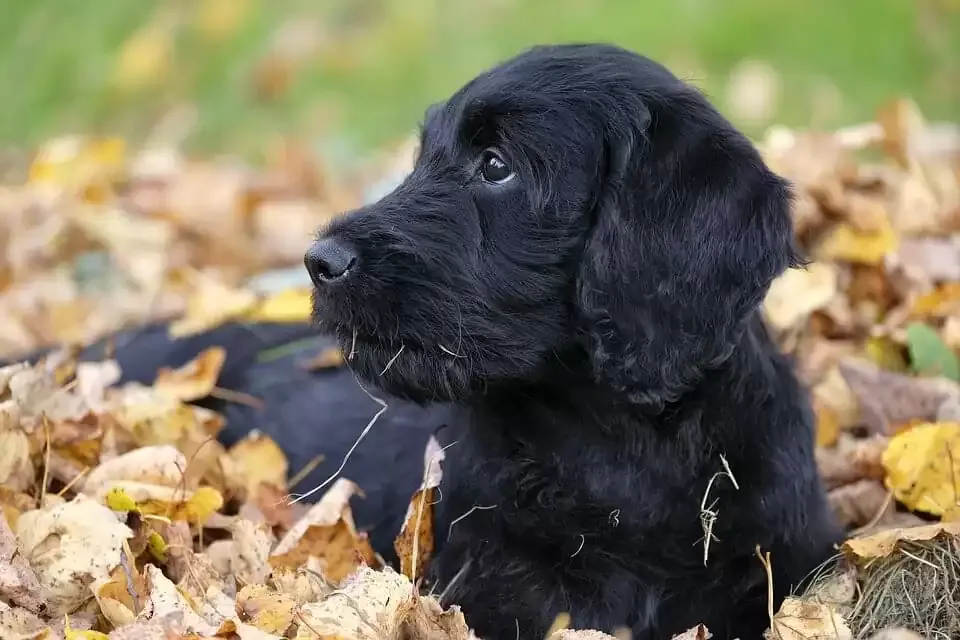 A friendly Labradoodle with a curly fleece coat, a popular medium low-shedding dog breed.A beloved crossbreed, the Labradoodle was originally developed to be a hypoallergenic guide dog with a low-shedding coat. Their coat types vary, including hair, wool, and fleece. The wool and fleece coats are generally the lowest shedding varieties and are often preferred by allergy sufferers. Regardless of the type, Labradoodles require consistent grooming. Weekly brushing is vital to prevent mats and tangles, especially in the denser wool and fleece coats. Regular professional grooming for trimming every 6-8 weeks is also highly recommended to maintain their coat health and manageability. When choosing a Labradoodle, it’s crucial to consult a reputable breeder to understand the specific coat type and its associated care. These cute medium dog breeds that don’t shed are often a top choice for families.
A friendly Labradoodle with a curly fleece coat, a popular medium low-shedding dog breed.A beloved crossbreed, the Labradoodle was originally developed to be a hypoallergenic guide dog with a low-shedding coat. Their coat types vary, including hair, wool, and fleece. The wool and fleece coats are generally the lowest shedding varieties and are often preferred by allergy sufferers. Regardless of the type, Labradoodles require consistent grooming. Weekly brushing is vital to prevent mats and tangles, especially in the denser wool and fleece coats. Regular professional grooming for trimming every 6-8 weeks is also highly recommended to maintain their coat health and manageability. When choosing a Labradoodle, it’s crucial to consult a reputable breeder to understand the specific coat type and its associated care. These cute medium dog breeds that don’t shed are often a top choice for families.
Irish Terrier
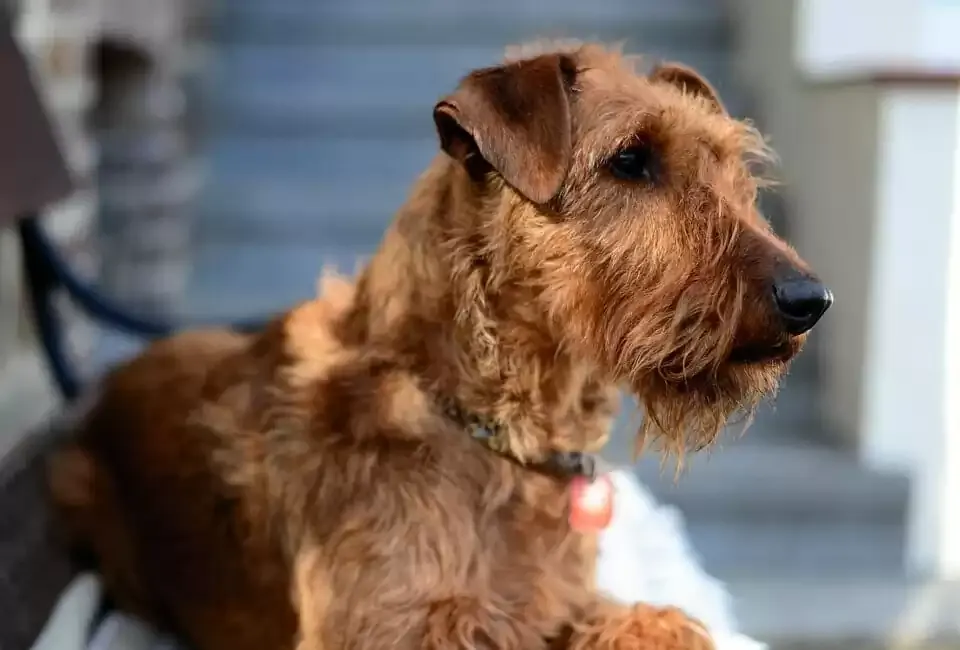 An alert Irish Terrier displaying its wiry red coat, a medium dog breed with low shedding tendencies.The Irish Terrier is a courageous and adventurous breed with a distinctive wiry, dense double coat. This coat structure effectively traps dead hairs, making them a low-shedding option for many households. However, this also means that the “shedding” must be manually removed through regular grooming. Owners should commit to weekly brushing to keep the coat healthy and free of loose hair. Furthermore, professional hand stripping or plucking every six months is necessary to remove dead outer coat hairs, encourage new growth, and maintain the coat’s characteristic texture and appearance.
An alert Irish Terrier displaying its wiry red coat, a medium dog breed with low shedding tendencies.The Irish Terrier is a courageous and adventurous breed with a distinctive wiry, dense double coat. This coat structure effectively traps dead hairs, making them a low-shedding option for many households. However, this also means that the “shedding” must be manually removed through regular grooming. Owners should commit to weekly brushing to keep the coat healthy and free of loose hair. Furthermore, professional hand stripping or plucking every six months is necessary to remove dead outer coat hairs, encourage new growth, and maintain the coat’s characteristic texture and appearance.
Puli
 A Puli dog with its unique corded coat, a medium-sized breed that requires specific grooming for its non-shedding fur.With its striking corded coat, the Puli is an unmistakable and engaging companion. While the mature corded coat requires minimal brushing, it demands a unique and significant grooming commitment, particularly during its formation. As young dogs, their fluffy coats need regular brushing to prevent matting. Once the cords begin to form, usually around 9-18 months, they must be meticulously separated by hand to create the distinctive dreadlock-like appearance. The formed cords then require regular separation and cleaning to prevent them from fusing together and to keep them free of debris. Consulting with an experienced Puli breeder or professional groomer is highly recommended to understand the intricacies of Puli coat care. Many consider the Puli among the best medium dog breeds that don’t shed due to its truly unique coat.
A Puli dog with its unique corded coat, a medium-sized breed that requires specific grooming for its non-shedding fur.With its striking corded coat, the Puli is an unmistakable and engaging companion. While the mature corded coat requires minimal brushing, it demands a unique and significant grooming commitment, particularly during its formation. As young dogs, their fluffy coats need regular brushing to prevent matting. Once the cords begin to form, usually around 9-18 months, they must be meticulously separated by hand to create the distinctive dreadlock-like appearance. The formed cords then require regular separation and cleaning to prevent them from fusing together and to keep them free of debris. Consulting with an experienced Puli breeder or professional groomer is highly recommended to understand the intricacies of Puli coat care. Many consider the Puli among the best medium dog breeds that don’t shed due to its truly unique coat.
Standard Schnauzer
 A majestic Standard Schnauzer, a medium dog breed known for its distinctive beard and low-shedding wiry coat.The Standard Schnauzer is a robust and intelligent breed known for its distinctive beard and expressive eyebrows. They possess a wiry outer coat and a soft undercoat, a combination that effectively traps loose hairs, making them a popular low-shedding choice. To maintain their handsome appearance and prevent painful mats, Standard Schnauzers require a considerable grooming regimen. Their beard and leg furnishings need daily attention to prevent tangles and keep them clean. The body coat benefits from hand stripping every six months, which helps remove dead hair and preserve the coat’s wiry texture. It’s important to note that clipping instead of stripping can soften the coat texture and may lead to slightly more shedding.
A majestic Standard Schnauzer, a medium dog breed known for its distinctive beard and low-shedding wiry coat.The Standard Schnauzer is a robust and intelligent breed known for its distinctive beard and expressive eyebrows. They possess a wiry outer coat and a soft undercoat, a combination that effectively traps loose hairs, making them a popular low-shedding choice. To maintain their handsome appearance and prevent painful mats, Standard Schnauzers require a considerable grooming regimen. Their beard and leg furnishings need daily attention to prevent tangles and keep them clean. The body coat benefits from hand stripping every six months, which helps remove dead hair and preserve the coat’s wiry texture. It’s important to note that clipping instead of stripping can soften the coat texture and may lead to slightly more shedding.
Tibetan Terrier
 A long-haired Tibetan Terrier, a medium dog breed valued for its beautiful, low-shedding double coat.Affectionately known as “Holy Dogs of Tibet,” these charming companions possess a luxurious long, flowing double coat that can be wavy or straight. While magnificent, this coat requires significant dedication to grooming to prevent tangles and mats. Daily brushing is essential to work through both the topcoat and the dense undercoat. Without this commitment, the coat can quickly become matted, leading to discomfort and potential skin problems for the dog. Many Tibetan Terrier owners opt for the expertise of a professional groomer to help manage this demanding coat, especially for full show coats. For those seeking small medium dog breeds that don’t shed with a beautiful, flowing coat, the Tibetan Terrier is a strong contender, provided you are ready for the grooming demands.
A long-haired Tibetan Terrier, a medium dog breed valued for its beautiful, low-shedding double coat.Affectionately known as “Holy Dogs of Tibet,” these charming companions possess a luxurious long, flowing double coat that can be wavy or straight. While magnificent, this coat requires significant dedication to grooming to prevent tangles and mats. Daily brushing is essential to work through both the topcoat and the dense undercoat. Without this commitment, the coat can quickly become matted, leading to discomfort and potential skin problems for the dog. Many Tibetan Terrier owners opt for the expertise of a professional groomer to help manage this demanding coat, especially for full show coats. For those seeking small medium dog breeds that don’t shed with a beautiful, flowing coat, the Tibetan Terrier is a strong contender, provided you are ready for the grooming demands.
Welsh Terrier
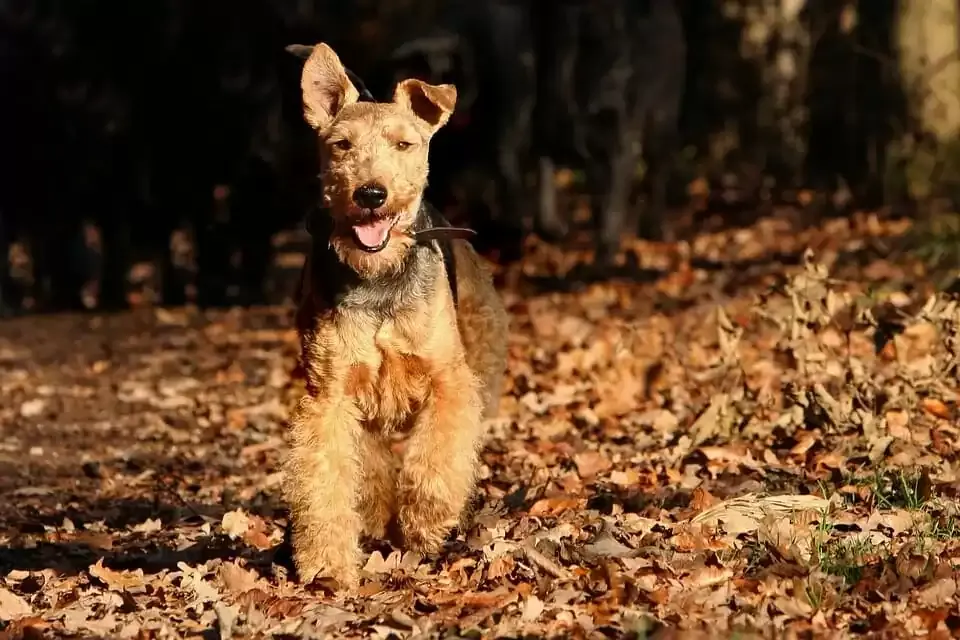 A curious Welsh Terrier with its characteristic black and tan wiry coat, a medium low-shedding dog breed.Lively, intelligent, and full of character, the Welsh Terrier shares many coat characteristics and grooming needs with its Irish Terrier cousin. Their wiry double coat is low-shedding but requires consistent attention to stay healthy and tidy. Brushing three or more times a week is necessary to remove dead hair and prevent matting. Similar to other wiry-coated terriers, professional hand stripping every six months is the preferred method for maintaining the coat’s texture and minimizing shedding. While clipping is an option, it can soften the coat and may result in a slight increase in shedding.
A curious Welsh Terrier with its characteristic black and tan wiry coat, a medium low-shedding dog breed.Lively, intelligent, and full of character, the Welsh Terrier shares many coat characteristics and grooming needs with its Irish Terrier cousin. Their wiry double coat is low-shedding but requires consistent attention to stay healthy and tidy. Brushing three or more times a week is necessary to remove dead hair and prevent matting. Similar to other wiry-coated terriers, professional hand stripping every six months is the preferred method for maintaining the coat’s texture and minimizing shedding. While clipping is an option, it can soften the coat and may result in a slight increase in shedding.
Soft-Coated Wheaten Terrier
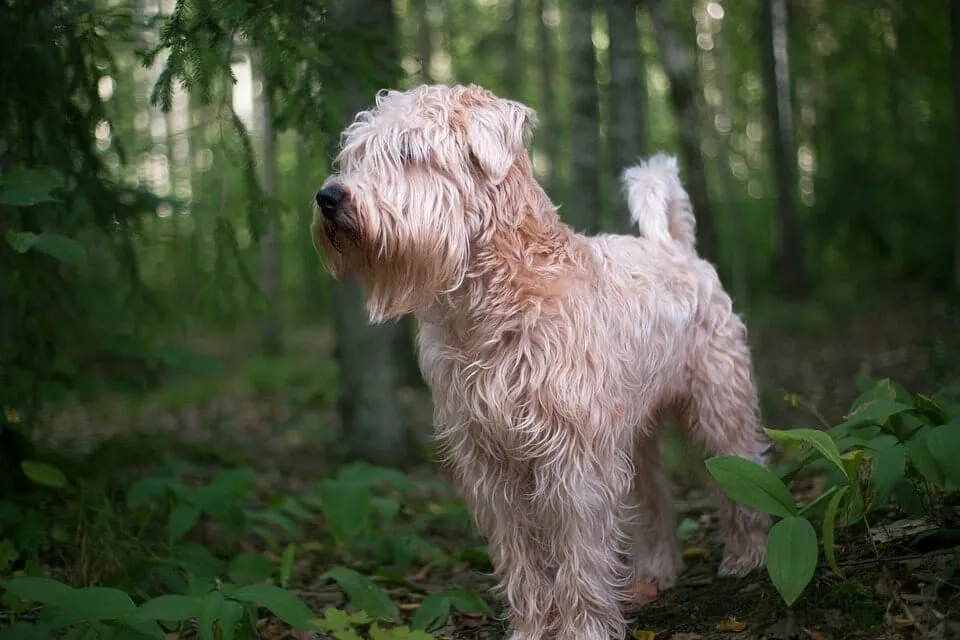 A cheerful Soft-Coated Wheaten Terrier with its soft, wavy golden coat, a medium dog breed that is a low shedder.The Soft-Coated Wheaten Terrier is adored for its silky, wavy, single coat that comes in various shades of wheat. This stunning coat is indeed low-shedding, but it is also prone to tangles and mats if not cared for diligently. Daily brushing is the ideal routine to keep their coat smooth and free from knots. Some owners who prefer a slightly scruffier look might find they can reduce brushing to three times a week, but vigilance against matting remains key. Regular trimming, either by the owner or a professional groomer, helps keep the coat manageable and tidy.
A cheerful Soft-Coated Wheaten Terrier with its soft, wavy golden coat, a medium dog breed that is a low shedder.The Soft-Coated Wheaten Terrier is adored for its silky, wavy, single coat that comes in various shades of wheat. This stunning coat is indeed low-shedding, but it is also prone to tangles and mats if not cared for diligently. Daily brushing is the ideal routine to keep their coat smooth and free from knots. Some owners who prefer a slightly scruffier look might find they can reduce brushing to three times a week, but vigilance against matting remains key. Regular trimming, either by the owner or a professional groomer, helps keep the coat manageable and tidy.
Whippet
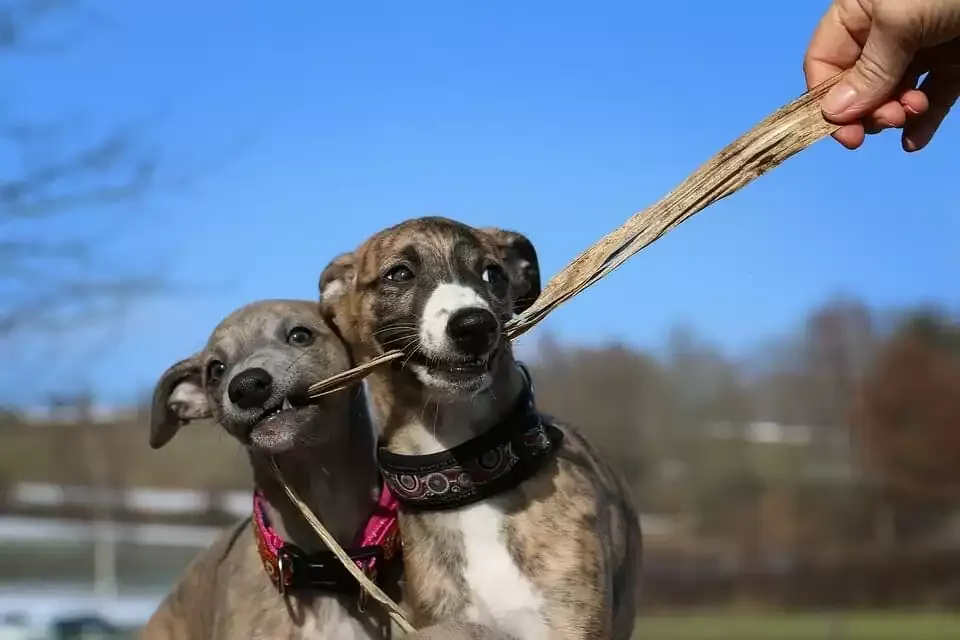 A sleek and agile Whippet, a medium-sized, low-shedding dog breed with a very short coat.Graceful, athletic, and gentle, the Whippet is a popular choice for those seeking a low-shedding dog with minimal grooming requirements. Their short, smooth, and thin coat is often described as “wash-and-wear,” making them one of the easiest breeds to maintain on this list. A simple weekly brush with a rubber mitt or soft brush is usually enough to remove any loose hairs and keep their coat looking sleek. However, due to their thin skin and short coat, extra care should be taken to protect them from injuries and extreme weather. Their minimal grooming needs make them an attractive option for many dog lovers.
A sleek and agile Whippet, a medium-sized, low-shedding dog breed with a very short coat.Graceful, athletic, and gentle, the Whippet is a popular choice for those seeking a low-shedding dog with minimal grooming requirements. Their short, smooth, and thin coat is often described as “wash-and-wear,” making them one of the easiest breeds to maintain on this list. A simple weekly brush with a rubber mitt or soft brush is usually enough to remove any loose hairs and keep their coat looking sleek. However, due to their thin skin and short coat, extra care should be taken to protect them from injuries and extreme weather. Their minimal grooming needs make them an attractive option for many dog lovers.
The Truth About “Hypoallergenic” Dogs and Allergies
It’s vital to address the term “hypoallergenic” accurately when discussing medium dog breeds that don’t shed. The popular notion that certain breeds are completely “hypoallergenic” is a myth. No dog is 100% hypoallergenic, as allergies are typically triggered by dander (flakes of skin), saliva, or urine, rather than just the hair itself. While low-shedding breeds may distribute fewer allergens into the environment simply because they shed less hair carrying dander, they still produce these allergens.
If you or a family member suffer from allergies, the first step should always be to consult a medical professional to identify your specific triggers. Knowing exactly what you are allergic to can help you make a more informed decision. Furthermore, before bringing any dog home, particularly if allergies are a concern, it is highly recommended to spend extended periods with the specific breed you are considering. Visit breeders, interact with adult dogs, and observe your reactions. This hands-on experience is the most reliable way to gauge whether your allergies can cope with constant contact.
Conclusion
Choosing a canine companion is a significant decision, and for many, finding a dog that minimizes shedding is a top priority. The medium dog breeds that don’t shed listed above offer fantastic options for those seeking less fur around the home. However, it’s essential to remember that “low-shedding” often translates to a higher commitment to grooming. Each breed comes with its unique coat type and specific care requirements, from daily brushing to professional stripping or cord separation.
By understanding these needs and honestly assessing your willingness to commit to the grooming routine, you can find a compatible companion that brings joy without the overwhelming fur. Always prioritize your lifestyle, research the breed thoroughly, and consider professional advice, especially regarding allergies. We hope this guide has provided valuable insights to help you find the perfect low-shedding, four-legged family member. For more expert advice on dog care and health, be sure to explore other articles on Dog Care Story.
References
- Australasian Society of Clinical Immunology. (n.d.). Pet Allergy. Retrieved from https://www.allergy.org.au/patients/other-allergy/pet-allergy
- The American Kennel Club. (n.d.). Dog Breeds. Retrieved from https://www.akc.org/dog-breeds/
